HRM Report: Analysis of Marriott International's HR Practices
VerifiedAdded on 2019/12/03
|14
|4706
|420
Report
AI Summary
This report provides a comprehensive analysis of Human Resource Management (HRM) practices at Marriott International Inc. It begins with an overview of HRM and its functions, focusing on Marriott's global operations. The report then delves into Human Resource Planning (HRP), outlining the stages involved and the reasons for HRP within Marriott, along with an examination of recruitment and selection processes, comparing Marriott's methods with those of Hilton Hotels. Furthermore, the report explores the link between motivational theories and reward systems, evaluating the effectiveness of job evaluation and reward systems in different contexts. It also covers performance monitoring, reasons for employment cessation, and exit procedures, including the impact of legal and regulatory frameworks. The report concludes with a summary of key findings and insights into Marriott's HRM strategies.
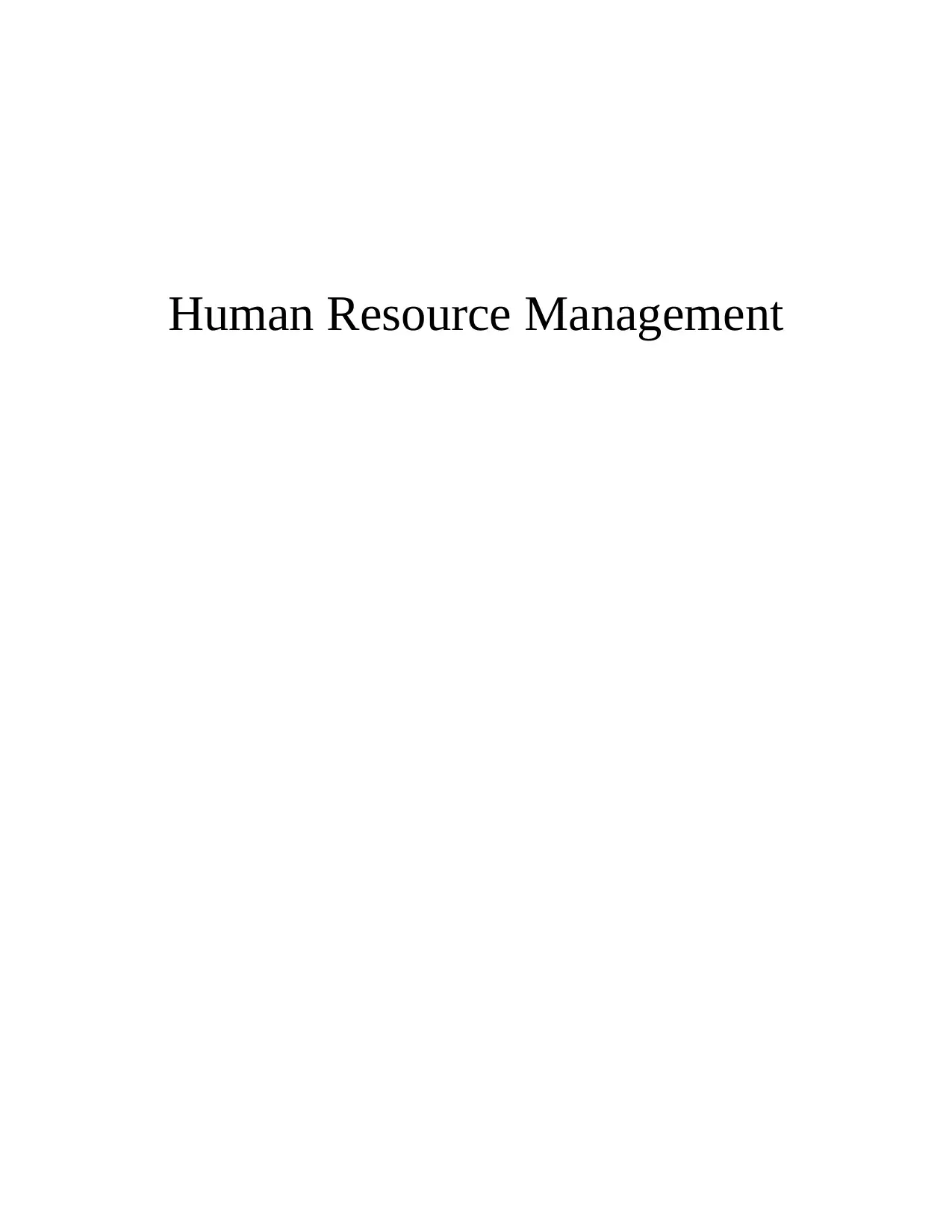
Human Resource Management
Paraphrase This Document
Need a fresh take? Get an instant paraphrase of this document with our AI Paraphraser
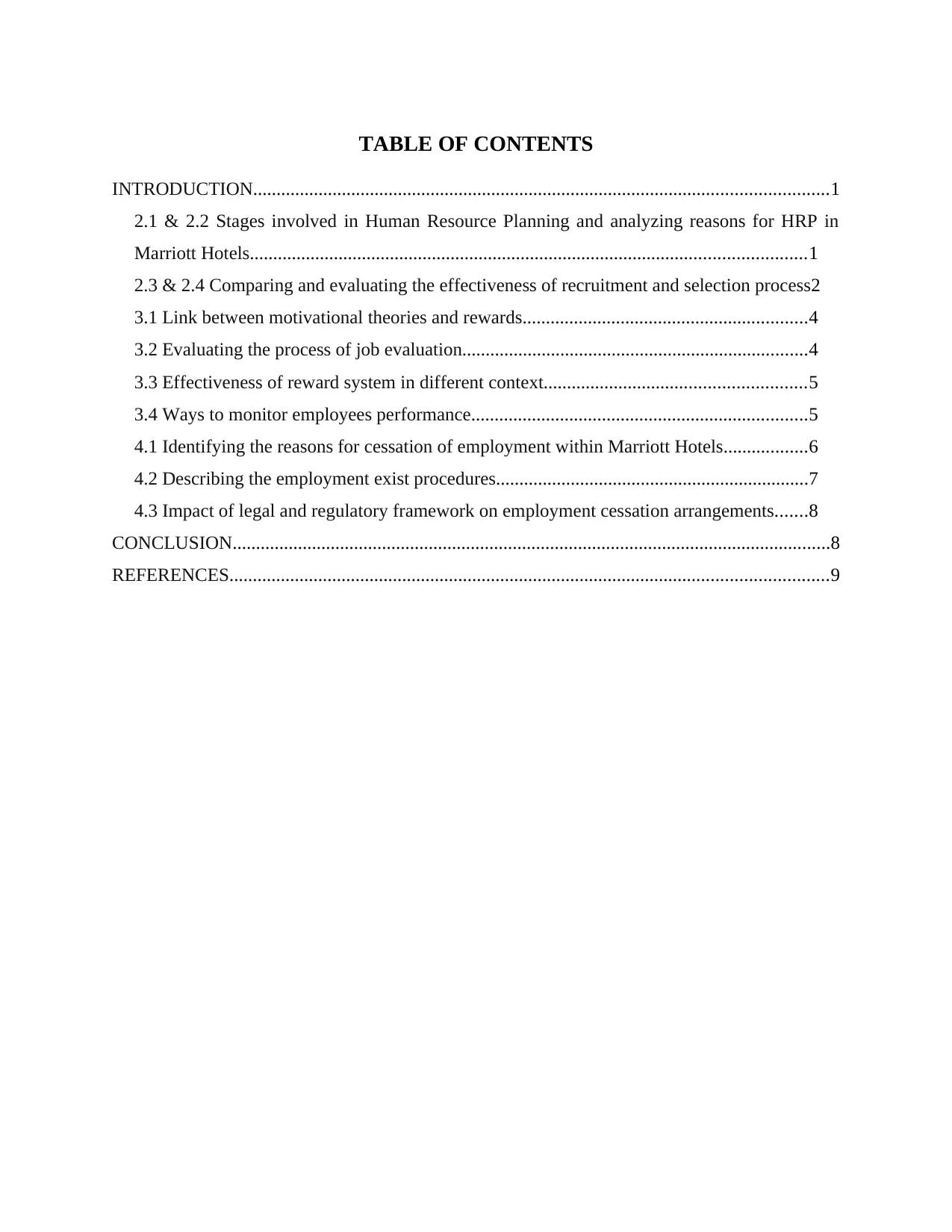
TABLE OF CONTENTS
INTRODUCTION...........................................................................................................................1
2.1 & 2.2 Stages involved in Human Resource Planning and analyzing reasons for HRP in
Marriott Hotels.......................................................................................................................1
2.3 & 2.4 Comparing and evaluating the effectiveness of recruitment and selection process2
3.1 Link between motivational theories and rewards.............................................................4
3.2 Evaluating the process of job evaluation..........................................................................4
3.3 Effectiveness of reward system in different context........................................................5
3.4 Ways to monitor employees performance........................................................................5
4.1 Identifying the reasons for cessation of employment within Marriott Hotels..................6
4.2 Describing the employment exist procedures...................................................................7
4.3 Impact of legal and regulatory framework on employment cessation arrangements.......8
CONCLUSION................................................................................................................................8
REFERENCES................................................................................................................................9
INTRODUCTION...........................................................................................................................1
2.1 & 2.2 Stages involved in Human Resource Planning and analyzing reasons for HRP in
Marriott Hotels.......................................................................................................................1
2.3 & 2.4 Comparing and evaluating the effectiveness of recruitment and selection process2
3.1 Link between motivational theories and rewards.............................................................4
3.2 Evaluating the process of job evaluation..........................................................................4
3.3 Effectiveness of reward system in different context........................................................5
3.4 Ways to monitor employees performance........................................................................5
4.1 Identifying the reasons for cessation of employment within Marriott Hotels..................6
4.2 Describing the employment exist procedures...................................................................7
4.3 Impact of legal and regulatory framework on employment cessation arrangements.......8
CONCLUSION................................................................................................................................8
REFERENCES................................................................................................................................9
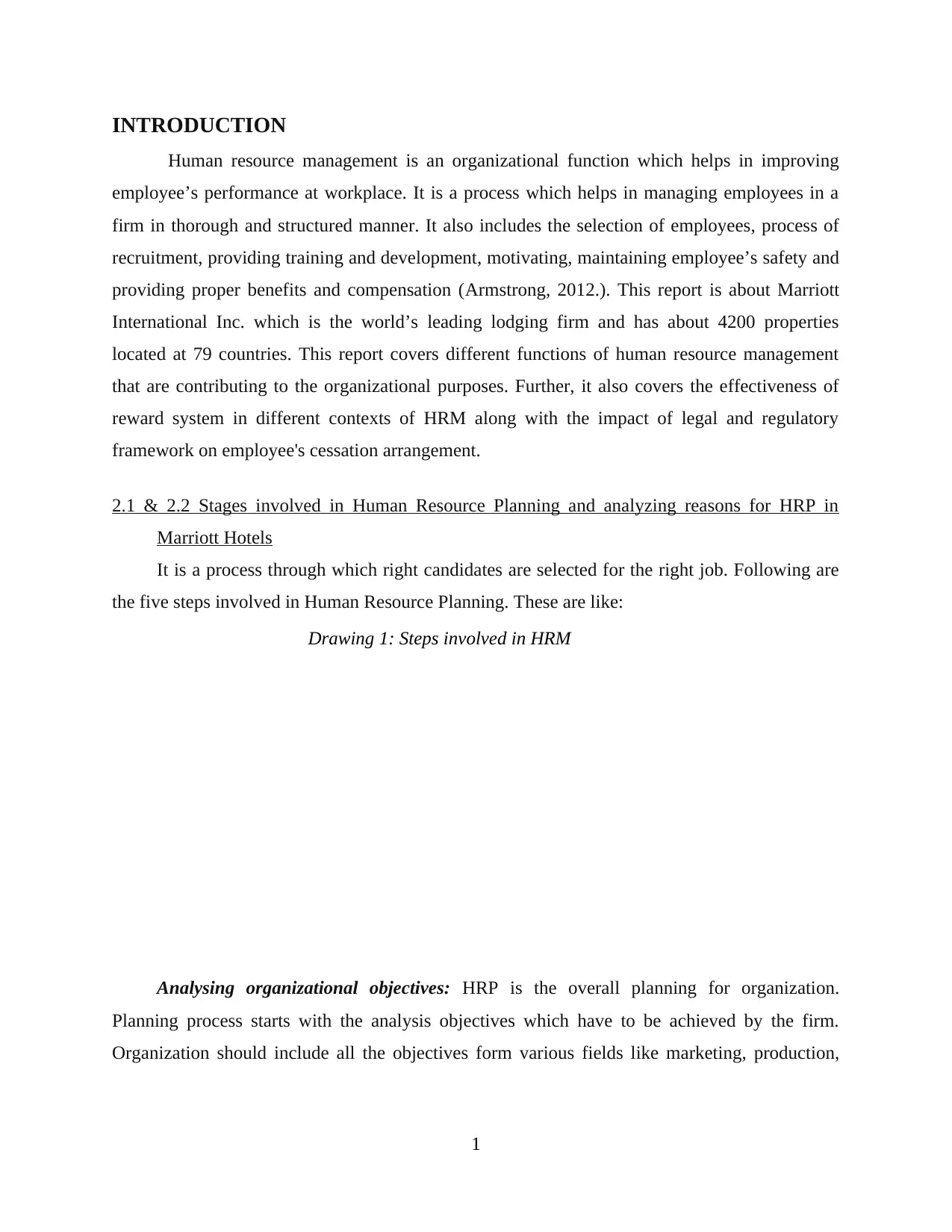
INTRODUCTION
Human resource management is an organizational function which helps in improving
employee’s performance at workplace. It is a process which helps in managing employees in a
firm in thorough and structured manner. It also includes the selection of employees, process of
recruitment, providing training and development, motivating, maintaining employee’s safety and
providing proper benefits and compensation (Armstrong, 2012.). This report is about Marriott
International Inc. which is the world’s leading lodging firm and has about 4200 properties
located at 79 countries. This report covers different functions of human resource management
that are contributing to the organizational purposes. Further, it also covers the effectiveness of
reward system in different contexts of HRM along with the impact of legal and regulatory
framework on employee's cessation arrangement.
2.1 & 2.2 Stages involved in Human Resource Planning and analyzing reasons for HRP in
Marriott Hotels
It is a process through which right candidates are selected for the right job. Following are
the five steps involved in Human Resource Planning. These are like:
Analysing organizational objectives: HRP is the overall planning for organization.
Planning process starts with the analysis objectives which have to be achieved by the firm.
Organization should include all the objectives form various fields like marketing, production,
1
Drawing 1: Steps involved in HRM
Human resource management is an organizational function which helps in improving
employee’s performance at workplace. It is a process which helps in managing employees in a
firm in thorough and structured manner. It also includes the selection of employees, process of
recruitment, providing training and development, motivating, maintaining employee’s safety and
providing proper benefits and compensation (Armstrong, 2012.). This report is about Marriott
International Inc. which is the world’s leading lodging firm and has about 4200 properties
located at 79 countries. This report covers different functions of human resource management
that are contributing to the organizational purposes. Further, it also covers the effectiveness of
reward system in different contexts of HRM along with the impact of legal and regulatory
framework on employee's cessation arrangement.
2.1 & 2.2 Stages involved in Human Resource Planning and analyzing reasons for HRP in
Marriott Hotels
It is a process through which right candidates are selected for the right job. Following are
the five steps involved in Human Resource Planning. These are like:
Analysing organizational objectives: HRP is the overall planning for organization.
Planning process starts with the analysis objectives which have to be achieved by the firm.
Organization should include all the objectives form various fields like marketing, production,
1
Drawing 1: Steps involved in HRM
⊘ This is a preview!⊘
Do you want full access?
Subscribe today to unlock all pages.

Trusted by 1+ million students worldwide
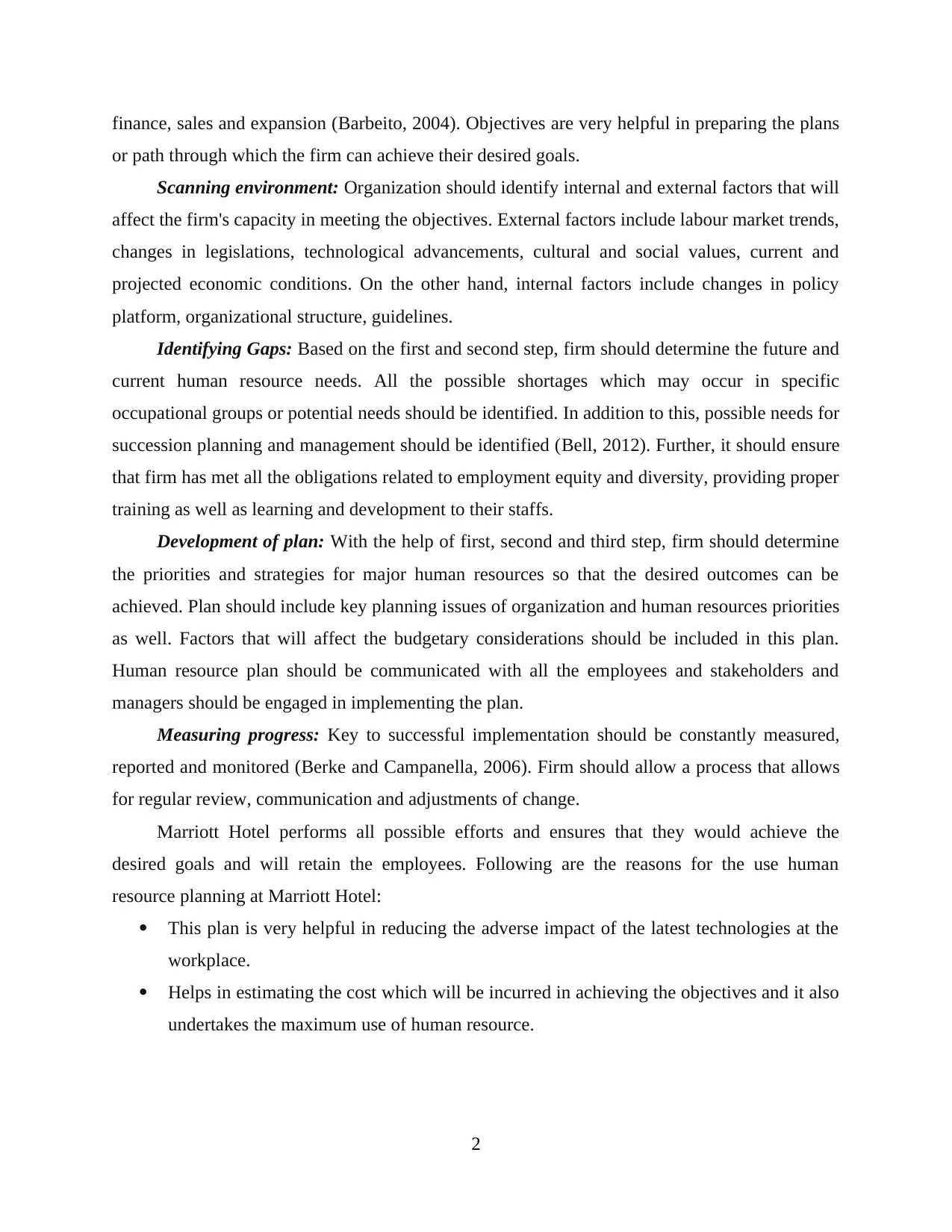
finance, sales and expansion (Barbeito, 2004). Objectives are very helpful in preparing the plans
or path through which the firm can achieve their desired goals.
Scanning environment: Organization should identify internal and external factors that will
affect the firm's capacity in meeting the objectives. External factors include labour market trends,
changes in legislations, technological advancements, cultural and social values, current and
projected economic conditions. On the other hand, internal factors include changes in policy
platform, organizational structure, guidelines.
Identifying Gaps: Based on the first and second step, firm should determine the future and
current human resource needs. All the possible shortages which may occur in specific
occupational groups or potential needs should be identified. In addition to this, possible needs for
succession planning and management should be identified (Bell, 2012). Further, it should ensure
that firm has met all the obligations related to employment equity and diversity, providing proper
training as well as learning and development to their staffs.
Development of plan: With the help of first, second and third step, firm should determine
the priorities and strategies for major human resources so that the desired outcomes can be
achieved. Plan should include key planning issues of organization and human resources priorities
as well. Factors that will affect the budgetary considerations should be included in this plan.
Human resource plan should be communicated with all the employees and stakeholders and
managers should be engaged in implementing the plan.
Measuring progress: Key to successful implementation should be constantly measured,
reported and monitored (Berke and Campanella, 2006). Firm should allow a process that allows
for regular review, communication and adjustments of change.
Marriott Hotel performs all possible efforts and ensures that they would achieve the
desired goals and will retain the employees. Following are the reasons for the use human
resource planning at Marriott Hotel:
This plan is very helpful in reducing the adverse impact of the latest technologies at the
workplace.
Helps in estimating the cost which will be incurred in achieving the objectives and it also
undertakes the maximum use of human resource.
2
or path through which the firm can achieve their desired goals.
Scanning environment: Organization should identify internal and external factors that will
affect the firm's capacity in meeting the objectives. External factors include labour market trends,
changes in legislations, technological advancements, cultural and social values, current and
projected economic conditions. On the other hand, internal factors include changes in policy
platform, organizational structure, guidelines.
Identifying Gaps: Based on the first and second step, firm should determine the future and
current human resource needs. All the possible shortages which may occur in specific
occupational groups or potential needs should be identified. In addition to this, possible needs for
succession planning and management should be identified (Bell, 2012). Further, it should ensure
that firm has met all the obligations related to employment equity and diversity, providing proper
training as well as learning and development to their staffs.
Development of plan: With the help of first, second and third step, firm should determine
the priorities and strategies for major human resources so that the desired outcomes can be
achieved. Plan should include key planning issues of organization and human resources priorities
as well. Factors that will affect the budgetary considerations should be included in this plan.
Human resource plan should be communicated with all the employees and stakeholders and
managers should be engaged in implementing the plan.
Measuring progress: Key to successful implementation should be constantly measured,
reported and monitored (Berke and Campanella, 2006). Firm should allow a process that allows
for regular review, communication and adjustments of change.
Marriott Hotel performs all possible efforts and ensures that they would achieve the
desired goals and will retain the employees. Following are the reasons for the use human
resource planning at Marriott Hotel:
This plan is very helpful in reducing the adverse impact of the latest technologies at the
workplace.
Helps in estimating the cost which will be incurred in achieving the objectives and it also
undertakes the maximum use of human resource.
2
Paraphrase This Document
Need a fresh take? Get an instant paraphrase of this document with our AI Paraphraser
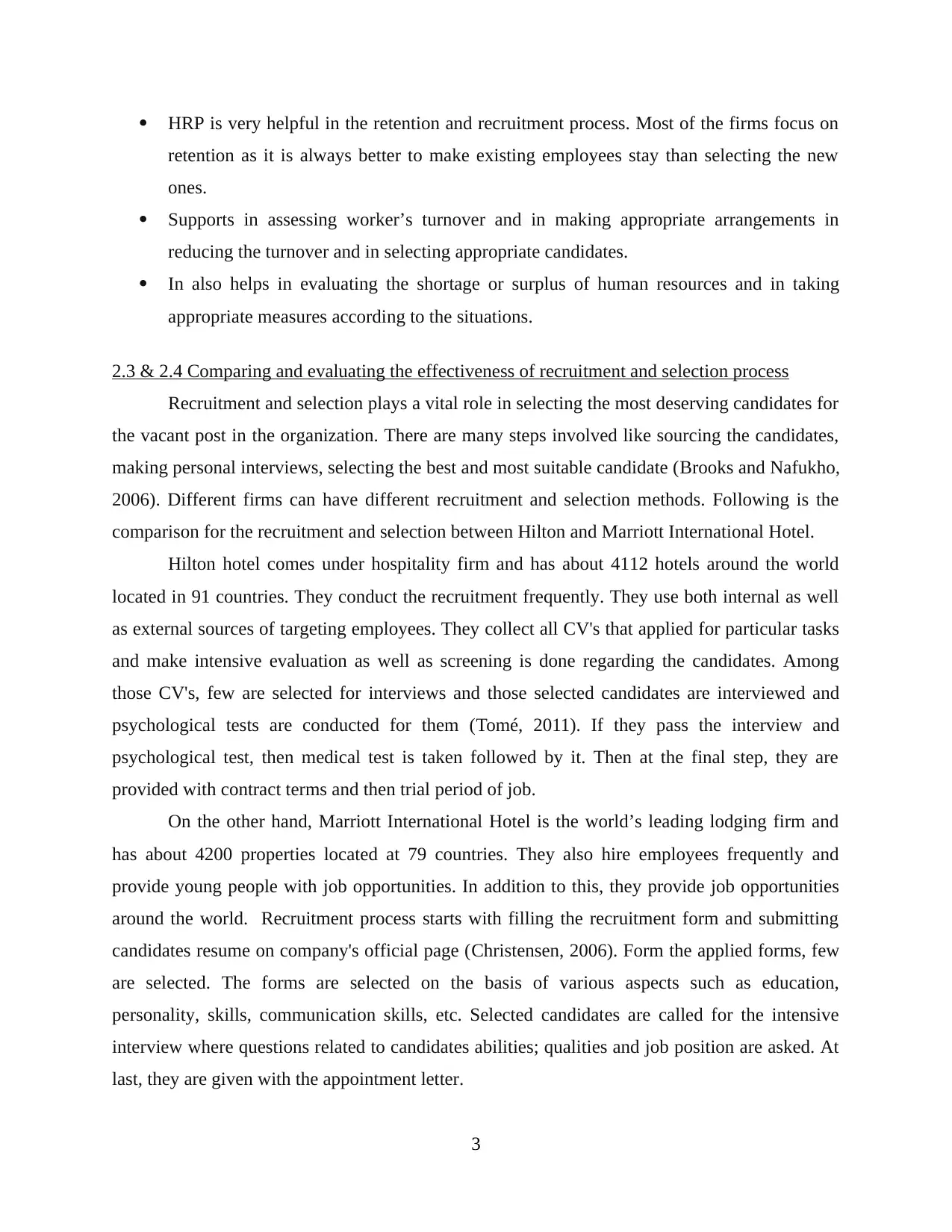
HRP is very helpful in the retention and recruitment process. Most of the firms focus on
retention as it is always better to make existing employees stay than selecting the new
ones.
Supports in assessing worker’s turnover and in making appropriate arrangements in
reducing the turnover and in selecting appropriate candidates.
In also helps in evaluating the shortage or surplus of human resources and in taking
appropriate measures according to the situations.
2.3 & 2.4 Comparing and evaluating the effectiveness of recruitment and selection process
Recruitment and selection plays a vital role in selecting the most deserving candidates for
the vacant post in the organization. There are many steps involved like sourcing the candidates,
making personal interviews, selecting the best and most suitable candidate (Brooks and Nafukho,
2006). Different firms can have different recruitment and selection methods. Following is the
comparison for the recruitment and selection between Hilton and Marriott International Hotel.
Hilton hotel comes under hospitality firm and has about 4112 hotels around the world
located in 91 countries. They conduct the recruitment frequently. They use both internal as well
as external sources of targeting employees. They collect all CV's that applied for particular tasks
and make intensive evaluation as well as screening is done regarding the candidates. Among
those CV's, few are selected for interviews and those selected candidates are interviewed and
psychological tests are conducted for them (Tomé, 2011). If they pass the interview and
psychological test, then medical test is taken followed by it. Then at the final step, they are
provided with contract terms and then trial period of job.
On the other hand, Marriott International Hotel is the world’s leading lodging firm and
has about 4200 properties located at 79 countries. They also hire employees frequently and
provide young people with job opportunities. In addition to this, they provide job opportunities
around the world. Recruitment process starts with filling the recruitment form and submitting
candidates resume on company's official page (Christensen, 2006). Form the applied forms, few
are selected. The forms are selected on the basis of various aspects such as education,
personality, skills, communication skills, etc. Selected candidates are called for the intensive
interview where questions related to candidates abilities; qualities and job position are asked. At
last, they are given with the appointment letter.
3
retention as it is always better to make existing employees stay than selecting the new
ones.
Supports in assessing worker’s turnover and in making appropriate arrangements in
reducing the turnover and in selecting appropriate candidates.
In also helps in evaluating the shortage or surplus of human resources and in taking
appropriate measures according to the situations.
2.3 & 2.4 Comparing and evaluating the effectiveness of recruitment and selection process
Recruitment and selection plays a vital role in selecting the most deserving candidates for
the vacant post in the organization. There are many steps involved like sourcing the candidates,
making personal interviews, selecting the best and most suitable candidate (Brooks and Nafukho,
2006). Different firms can have different recruitment and selection methods. Following is the
comparison for the recruitment and selection between Hilton and Marriott International Hotel.
Hilton hotel comes under hospitality firm and has about 4112 hotels around the world
located in 91 countries. They conduct the recruitment frequently. They use both internal as well
as external sources of targeting employees. They collect all CV's that applied for particular tasks
and make intensive evaluation as well as screening is done regarding the candidates. Among
those CV's, few are selected for interviews and those selected candidates are interviewed and
psychological tests are conducted for them (Tomé, 2011). If they pass the interview and
psychological test, then medical test is taken followed by it. Then at the final step, they are
provided with contract terms and then trial period of job.
On the other hand, Marriott International Hotel is the world’s leading lodging firm and
has about 4200 properties located at 79 countries. They also hire employees frequently and
provide young people with job opportunities. In addition to this, they provide job opportunities
around the world. Recruitment process starts with filling the recruitment form and submitting
candidates resume on company's official page (Christensen, 2006). Form the applied forms, few
are selected. The forms are selected on the basis of various aspects such as education,
personality, skills, communication skills, etc. Selected candidates are called for the intensive
interview where questions related to candidates abilities; qualities and job position are asked. At
last, they are given with the appointment letter.
3
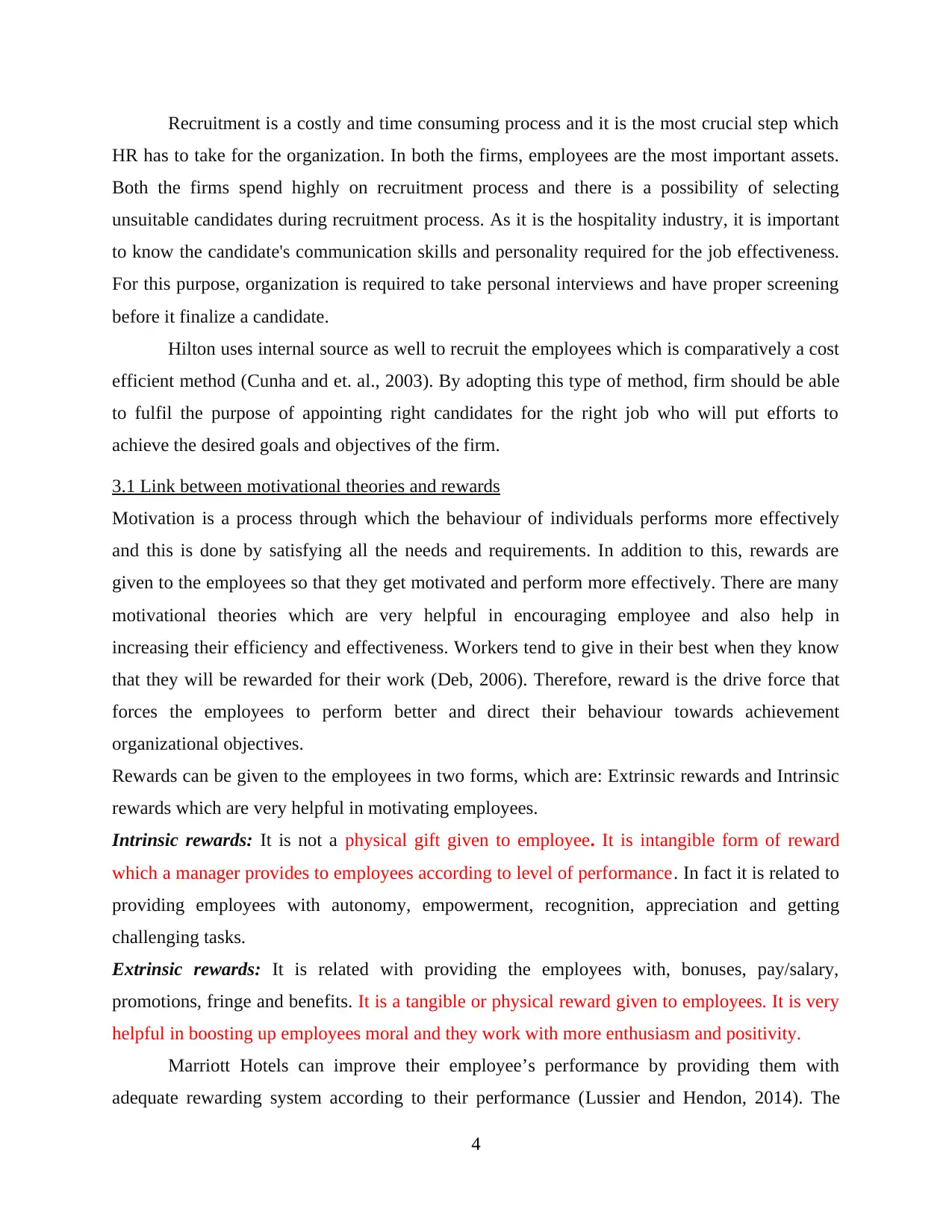
Recruitment is a costly and time consuming process and it is the most crucial step which
HR has to take for the organization. In both the firms, employees are the most important assets.
Both the firms spend highly on recruitment process and there is a possibility of selecting
unsuitable candidates during recruitment process. As it is the hospitality industry, it is important
to know the candidate's communication skills and personality required for the job effectiveness.
For this purpose, organization is required to take personal interviews and have proper screening
before it finalize a candidate.
Hilton uses internal source as well to recruit the employees which is comparatively a cost
efficient method (Cunha and et. al., 2003). By adopting this type of method, firm should be able
to fulfil the purpose of appointing right candidates for the right job who will put efforts to
achieve the desired goals and objectives of the firm.
3.1 Link between motivational theories and rewards
Motivation is a process through which the behaviour of individuals performs more effectively
and this is done by satisfying all the needs and requirements. In addition to this, rewards are
given to the employees so that they get motivated and perform more effectively. There are many
motivational theories which are very helpful in encouraging employee and also help in
increasing their efficiency and effectiveness. Workers tend to give in their best when they know
that they will be rewarded for their work (Deb, 2006). Therefore, reward is the drive force that
forces the employees to perform better and direct their behaviour towards achievement
organizational objectives.
Rewards can be given to the employees in two forms, which are: Extrinsic rewards and Intrinsic
rewards which are very helpful in motivating employees.
Intrinsic rewards: It is not a physical gift given to employee. It is intangible form of reward
which a manager provides to employees according to level of performance. In fact it is related to
providing employees with autonomy, empowerment, recognition, appreciation and getting
challenging tasks.
Extrinsic rewards: It is related with providing the employees with, bonuses, pay/salary,
promotions, fringe and benefits. It is a tangible or physical reward given to employees. It is very
helpful in boosting up employees moral and they work with more enthusiasm and positivity.
Marriott Hotels can improve their employee’s performance by providing them with
adequate rewarding system according to their performance (Lussier and Hendon, 2014). The
4
HR has to take for the organization. In both the firms, employees are the most important assets.
Both the firms spend highly on recruitment process and there is a possibility of selecting
unsuitable candidates during recruitment process. As it is the hospitality industry, it is important
to know the candidate's communication skills and personality required for the job effectiveness.
For this purpose, organization is required to take personal interviews and have proper screening
before it finalize a candidate.
Hilton uses internal source as well to recruit the employees which is comparatively a cost
efficient method (Cunha and et. al., 2003). By adopting this type of method, firm should be able
to fulfil the purpose of appointing right candidates for the right job who will put efforts to
achieve the desired goals and objectives of the firm.
3.1 Link between motivational theories and rewards
Motivation is a process through which the behaviour of individuals performs more effectively
and this is done by satisfying all the needs and requirements. In addition to this, rewards are
given to the employees so that they get motivated and perform more effectively. There are many
motivational theories which are very helpful in encouraging employee and also help in
increasing their efficiency and effectiveness. Workers tend to give in their best when they know
that they will be rewarded for their work (Deb, 2006). Therefore, reward is the drive force that
forces the employees to perform better and direct their behaviour towards achievement
organizational objectives.
Rewards can be given to the employees in two forms, which are: Extrinsic rewards and Intrinsic
rewards which are very helpful in motivating employees.
Intrinsic rewards: It is not a physical gift given to employee. It is intangible form of reward
which a manager provides to employees according to level of performance. In fact it is related to
providing employees with autonomy, empowerment, recognition, appreciation and getting
challenging tasks.
Extrinsic rewards: It is related with providing the employees with, bonuses, pay/salary,
promotions, fringe and benefits. It is a tangible or physical reward given to employees. It is very
helpful in boosting up employees moral and they work with more enthusiasm and positivity.
Marriott Hotels can improve their employee’s performance by providing them with
adequate rewarding system according to their performance (Lussier and Hendon, 2014). The
4
⊘ This is a preview!⊘
Do you want full access?
Subscribe today to unlock all pages.

Trusted by 1+ million students worldwide
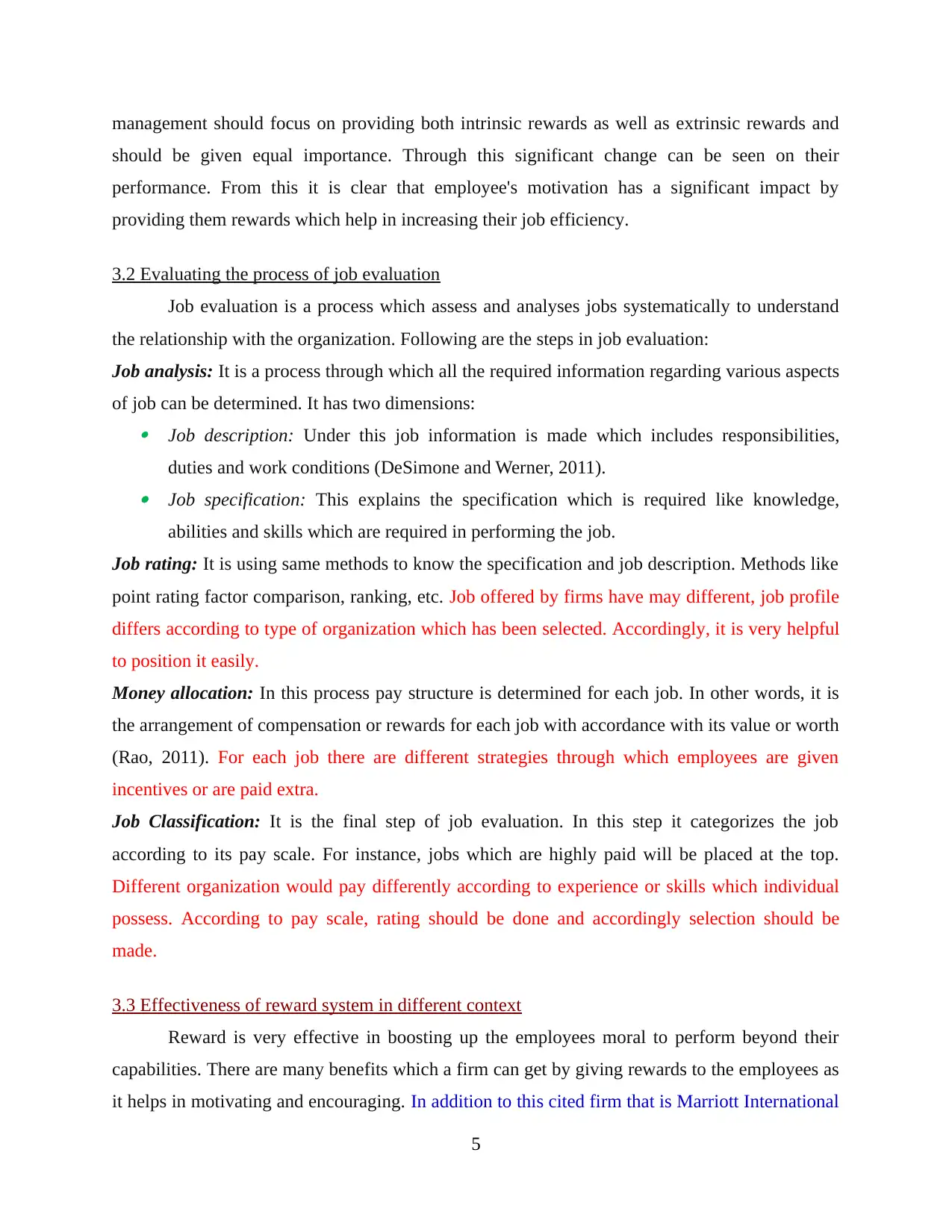
management should focus on providing both intrinsic rewards as well as extrinsic rewards and
should be given equal importance. Through this significant change can be seen on their
performance. From this it is clear that employee's motivation has a significant impact by
providing them rewards which help in increasing their job efficiency.
3.2 Evaluating the process of job evaluation
Job evaluation is a process which assess and analyses jobs systematically to understand
the relationship with the organization. Following are the steps in job evaluation:
Job analysis: It is a process through which all the required information regarding various aspects
of job can be determined. It has two dimensions: Job description: Under this job information is made which includes responsibilities,
duties and work conditions (DeSimone and Werner, 2011). Job specification: This explains the specification which is required like knowledge,
abilities and skills which are required in performing the job.
Job rating: It is using same methods to know the specification and job description. Methods like
point rating factor comparison, ranking, etc. Job offered by firms have may different, job profile
differs according to type of organization which has been selected. Accordingly, it is very helpful
to position it easily.
Money allocation: In this process pay structure is determined for each job. In other words, it is
the arrangement of compensation or rewards for each job with accordance with its value or worth
(Rao, 2011). For each job there are different strategies through which employees are given
incentives or are paid extra.
Job Classification: It is the final step of job evaluation. In this step it categorizes the job
according to its pay scale. For instance, jobs which are highly paid will be placed at the top.
Different organization would pay differently according to experience or skills which individual
possess. According to pay scale, rating should be done and accordingly selection should be
made.
3.3 Effectiveness of reward system in different context
Reward is very effective in boosting up the employees moral to perform beyond their
capabilities. There are many benefits which a firm can get by giving rewards to the employees as
it helps in motivating and encouraging. In addition to this cited firm that is Marriott International
5
should be given equal importance. Through this significant change can be seen on their
performance. From this it is clear that employee's motivation has a significant impact by
providing them rewards which help in increasing their job efficiency.
3.2 Evaluating the process of job evaluation
Job evaluation is a process which assess and analyses jobs systematically to understand
the relationship with the organization. Following are the steps in job evaluation:
Job analysis: It is a process through which all the required information regarding various aspects
of job can be determined. It has two dimensions: Job description: Under this job information is made which includes responsibilities,
duties and work conditions (DeSimone and Werner, 2011). Job specification: This explains the specification which is required like knowledge,
abilities and skills which are required in performing the job.
Job rating: It is using same methods to know the specification and job description. Methods like
point rating factor comparison, ranking, etc. Job offered by firms have may different, job profile
differs according to type of organization which has been selected. Accordingly, it is very helpful
to position it easily.
Money allocation: In this process pay structure is determined for each job. In other words, it is
the arrangement of compensation or rewards for each job with accordance with its value or worth
(Rao, 2011). For each job there are different strategies through which employees are given
incentives or are paid extra.
Job Classification: It is the final step of job evaluation. In this step it categorizes the job
according to its pay scale. For instance, jobs which are highly paid will be placed at the top.
Different organization would pay differently according to experience or skills which individual
possess. According to pay scale, rating should be done and accordingly selection should be
made.
3.3 Effectiveness of reward system in different context
Reward is very effective in boosting up the employees moral to perform beyond their
capabilities. There are many benefits which a firm can get by giving rewards to the employees as
it helps in motivating and encouraging. In addition to this cited firm that is Marriott International
5
Paraphrase This Document
Need a fresh take? Get an instant paraphrase of this document with our AI Paraphraser
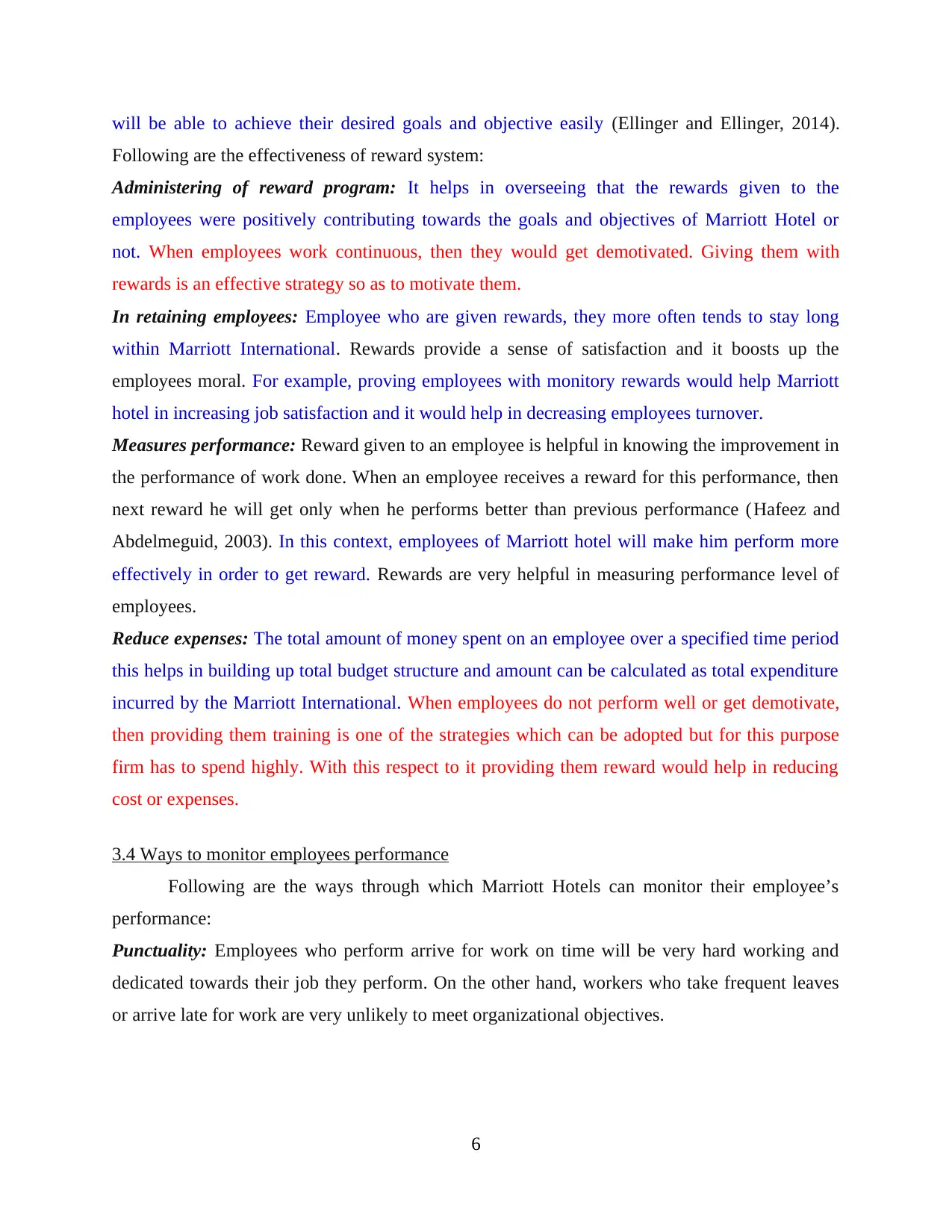
will be able to achieve their desired goals and objective easily (Ellinger and Ellinger, 2014).
Following are the effectiveness of reward system:
Administering of reward program: It helps in overseeing that the rewards given to the
employees were positively contributing towards the goals and objectives of Marriott Hotel or
not. When employees work continuous, then they would get demotivated. Giving them with
rewards is an effective strategy so as to motivate them.
In retaining employees: Employee who are given rewards, they more often tends to stay long
within Marriott International. Rewards provide a sense of satisfaction and it boosts up the
employees moral. For example, proving employees with monitory rewards would help Marriott
hotel in increasing job satisfaction and it would help in decreasing employees turnover.
Measures performance: Reward given to an employee is helpful in knowing the improvement in
the performance of work done. When an employee receives a reward for this performance, then
next reward he will get only when he performs better than previous performance (Hafeez and
Abdelmeguid, 2003). In this context, employees of Marriott hotel will make him perform more
effectively in order to get reward. Rewards are very helpful in measuring performance level of
employees.
Reduce expenses: The total amount of money spent on an employee over a specified time period
this helps in building up total budget structure and amount can be calculated as total expenditure
incurred by the Marriott International. When employees do not perform well or get demotivate,
then providing them training is one of the strategies which can be adopted but for this purpose
firm has to spend highly. With this respect to it providing them reward would help in reducing
cost or expenses.
3.4 Ways to monitor employees performance
Following are the ways through which Marriott Hotels can monitor their employee’s
performance:
Punctuality: Employees who perform arrive for work on time will be very hard working and
dedicated towards their job they perform. On the other hand, workers who take frequent leaves
or arrive late for work are very unlikely to meet organizational objectives.
6
Following are the effectiveness of reward system:
Administering of reward program: It helps in overseeing that the rewards given to the
employees were positively contributing towards the goals and objectives of Marriott Hotel or
not. When employees work continuous, then they would get demotivated. Giving them with
rewards is an effective strategy so as to motivate them.
In retaining employees: Employee who are given rewards, they more often tends to stay long
within Marriott International. Rewards provide a sense of satisfaction and it boosts up the
employees moral. For example, proving employees with monitory rewards would help Marriott
hotel in increasing job satisfaction and it would help in decreasing employees turnover.
Measures performance: Reward given to an employee is helpful in knowing the improvement in
the performance of work done. When an employee receives a reward for this performance, then
next reward he will get only when he performs better than previous performance (Hafeez and
Abdelmeguid, 2003). In this context, employees of Marriott hotel will make him perform more
effectively in order to get reward. Rewards are very helpful in measuring performance level of
employees.
Reduce expenses: The total amount of money spent on an employee over a specified time period
this helps in building up total budget structure and amount can be calculated as total expenditure
incurred by the Marriott International. When employees do not perform well or get demotivate,
then providing them training is one of the strategies which can be adopted but for this purpose
firm has to spend highly. With this respect to it providing them reward would help in reducing
cost or expenses.
3.4 Ways to monitor employees performance
Following are the ways through which Marriott Hotels can monitor their employee’s
performance:
Punctuality: Employees who perform arrive for work on time will be very hard working and
dedicated towards their job they perform. On the other hand, workers who take frequent leaves
or arrive late for work are very unlikely to meet organizational objectives.
6
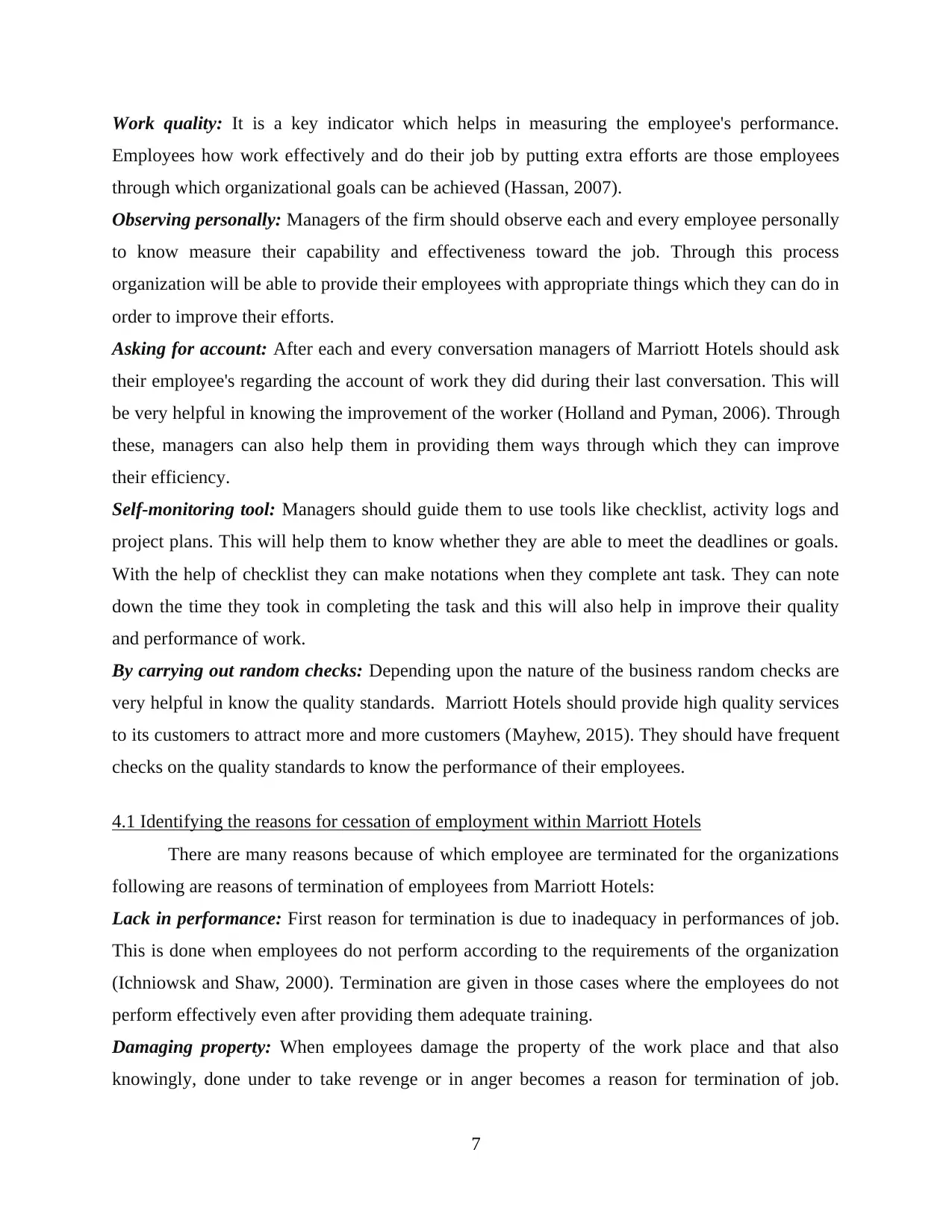
Work quality: It is a key indicator which helps in measuring the employee's performance.
Employees how work effectively and do their job by putting extra efforts are those employees
through which organizational goals can be achieved (Hassan, 2007).
Observing personally: Managers of the firm should observe each and every employee personally
to know measure their capability and effectiveness toward the job. Through this process
organization will be able to provide their employees with appropriate things which they can do in
order to improve their efforts.
Asking for account: After each and every conversation managers of Marriott Hotels should ask
their employee's regarding the account of work they did during their last conversation. This will
be very helpful in knowing the improvement of the worker (Holland and Pyman, 2006). Through
these, managers can also help them in providing them ways through which they can improve
their efficiency.
Self-monitoring tool: Managers should guide them to use tools like checklist, activity logs and
project plans. This will help them to know whether they are able to meet the deadlines or goals.
With the help of checklist they can make notations when they complete ant task. They can note
down the time they took in completing the task and this will also help in improve their quality
and performance of work.
By carrying out random checks: Depending upon the nature of the business random checks are
very helpful in know the quality standards. Marriott Hotels should provide high quality services
to its customers to attract more and more customers (Mayhew, 2015). They should have frequent
checks on the quality standards to know the performance of their employees.
4.1 Identifying the reasons for cessation of employment within Marriott Hotels
There are many reasons because of which employee are terminated for the organizations
following are reasons of termination of employees from Marriott Hotels:
Lack in performance: First reason for termination is due to inadequacy in performances of job.
This is done when employees do not perform according to the requirements of the organization
(Ichniowsk and Shaw, 2000). Termination are given in those cases where the employees do not
perform effectively even after providing them adequate training.
Damaging property: When employees damage the property of the work place and that also
knowingly, done under to take revenge or in anger becomes a reason for termination of job.
7
Employees how work effectively and do their job by putting extra efforts are those employees
through which organizational goals can be achieved (Hassan, 2007).
Observing personally: Managers of the firm should observe each and every employee personally
to know measure their capability and effectiveness toward the job. Through this process
organization will be able to provide their employees with appropriate things which they can do in
order to improve their efforts.
Asking for account: After each and every conversation managers of Marriott Hotels should ask
their employee's regarding the account of work they did during their last conversation. This will
be very helpful in knowing the improvement of the worker (Holland and Pyman, 2006). Through
these, managers can also help them in providing them ways through which they can improve
their efficiency.
Self-monitoring tool: Managers should guide them to use tools like checklist, activity logs and
project plans. This will help them to know whether they are able to meet the deadlines or goals.
With the help of checklist they can make notations when they complete ant task. They can note
down the time they took in completing the task and this will also help in improve their quality
and performance of work.
By carrying out random checks: Depending upon the nature of the business random checks are
very helpful in know the quality standards. Marriott Hotels should provide high quality services
to its customers to attract more and more customers (Mayhew, 2015). They should have frequent
checks on the quality standards to know the performance of their employees.
4.1 Identifying the reasons for cessation of employment within Marriott Hotels
There are many reasons because of which employee are terminated for the organizations
following are reasons of termination of employees from Marriott Hotels:
Lack in performance: First reason for termination is due to inadequacy in performances of job.
This is done when employees do not perform according to the requirements of the organization
(Ichniowsk and Shaw, 2000). Termination are given in those cases where the employees do not
perform effectively even after providing them adequate training.
Damaging property: When employees damage the property of the work place and that also
knowingly, done under to take revenge or in anger becomes a reason for termination of job.
7
⊘ This is a preview!⊘
Do you want full access?
Subscribe today to unlock all pages.

Trusted by 1+ million students worldwide
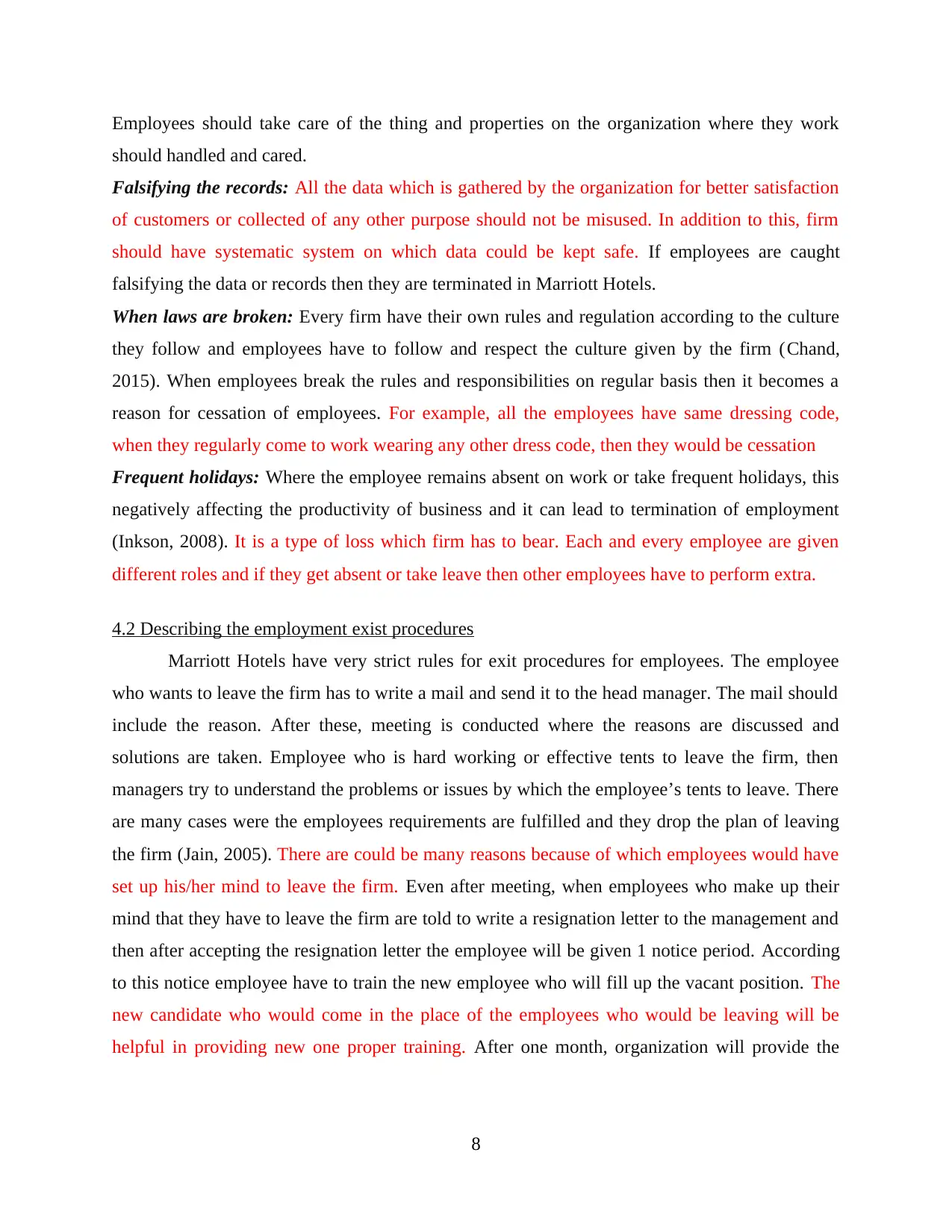
Employees should take care of the thing and properties on the organization where they work
should handled and cared.
Falsifying the records: All the data which is gathered by the organization for better satisfaction
of customers or collected of any other purpose should not be misused. In addition to this, firm
should have systematic system on which data could be kept safe. If employees are caught
falsifying the data or records then they are terminated in Marriott Hotels.
When laws are broken: Every firm have their own rules and regulation according to the culture
they follow and employees have to follow and respect the culture given by the firm (Chand,
2015). When employees break the rules and responsibilities on regular basis then it becomes a
reason for cessation of employees. For example, all the employees have same dressing code,
when they regularly come to work wearing any other dress code, then they would be cessation
Frequent holidays: Where the employee remains absent on work or take frequent holidays, this
negatively affecting the productivity of business and it can lead to termination of employment
(Inkson, 2008). It is a type of loss which firm has to bear. Each and every employee are given
different roles and if they get absent or take leave then other employees have to perform extra.
4.2 Describing the employment exist procedures
Marriott Hotels have very strict rules for exit procedures for employees. The employee
who wants to leave the firm has to write a mail and send it to the head manager. The mail should
include the reason. After these, meeting is conducted where the reasons are discussed and
solutions are taken. Employee who is hard working or effective tents to leave the firm, then
managers try to understand the problems or issues by which the employee’s tents to leave. There
are many cases were the employees requirements are fulfilled and they drop the plan of leaving
the firm (Jain, 2005). There are could be many reasons because of which employees would have
set up his/her mind to leave the firm. Even after meeting, when employees who make up their
mind that they have to leave the firm are told to write a resignation letter to the management and
then after accepting the resignation letter the employee will be given 1 notice period. According
to this notice employee have to train the new employee who will fill up the vacant position. The
new candidate who would come in the place of the employees who would be leaving will be
helpful in providing new one proper training. After one month, organization will provide the
8
should handled and cared.
Falsifying the records: All the data which is gathered by the organization for better satisfaction
of customers or collected of any other purpose should not be misused. In addition to this, firm
should have systematic system on which data could be kept safe. If employees are caught
falsifying the data or records then they are terminated in Marriott Hotels.
When laws are broken: Every firm have their own rules and regulation according to the culture
they follow and employees have to follow and respect the culture given by the firm (Chand,
2015). When employees break the rules and responsibilities on regular basis then it becomes a
reason for cessation of employees. For example, all the employees have same dressing code,
when they regularly come to work wearing any other dress code, then they would be cessation
Frequent holidays: Where the employee remains absent on work or take frequent holidays, this
negatively affecting the productivity of business and it can lead to termination of employment
(Inkson, 2008). It is a type of loss which firm has to bear. Each and every employee are given
different roles and if they get absent or take leave then other employees have to perform extra.
4.2 Describing the employment exist procedures
Marriott Hotels have very strict rules for exit procedures for employees. The employee
who wants to leave the firm has to write a mail and send it to the head manager. The mail should
include the reason. After these, meeting is conducted where the reasons are discussed and
solutions are taken. Employee who is hard working or effective tents to leave the firm, then
managers try to understand the problems or issues by which the employee’s tents to leave. There
are many cases were the employees requirements are fulfilled and they drop the plan of leaving
the firm (Jain, 2005). There are could be many reasons because of which employees would have
set up his/her mind to leave the firm. Even after meeting, when employees who make up their
mind that they have to leave the firm are told to write a resignation letter to the management and
then after accepting the resignation letter the employee will be given 1 notice period. According
to this notice employee have to train the new employee who will fill up the vacant position. The
new candidate who would come in the place of the employees who would be leaving will be
helpful in providing new one proper training. After one month, organization will provide the
8
Paraphrase This Document
Need a fresh take? Get an instant paraphrase of this document with our AI Paraphraser
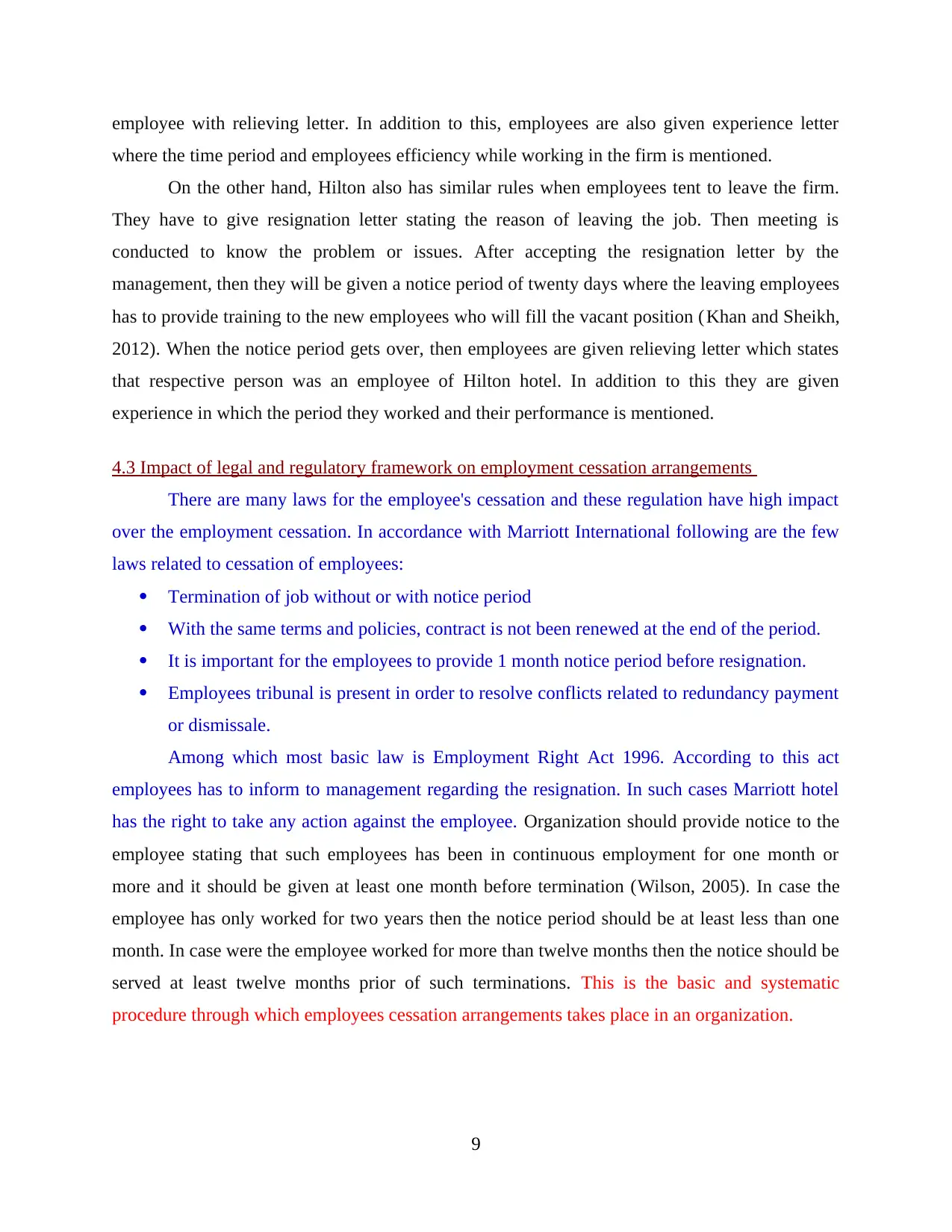
employee with relieving letter. In addition to this, employees are also given experience letter
where the time period and employees efficiency while working in the firm is mentioned.
On the other hand, Hilton also has similar rules when employees tent to leave the firm.
They have to give resignation letter stating the reason of leaving the job. Then meeting is
conducted to know the problem or issues. After accepting the resignation letter by the
management, then they will be given a notice period of twenty days where the leaving employees
has to provide training to the new employees who will fill the vacant position (Khan and Sheikh,
2012). When the notice period gets over, then employees are given relieving letter which states
that respective person was an employee of Hilton hotel. In addition to this they are given
experience in which the period they worked and their performance is mentioned.
4.3 Impact of legal and regulatory framework on employment cessation arrangements
There are many laws for the employee's cessation and these regulation have high impact
over the employment cessation. In accordance with Marriott International following are the few
laws related to cessation of employees:
Termination of job without or with notice period
With the same terms and policies, contract is not been renewed at the end of the period.
It is important for the employees to provide 1 month notice period before resignation.
Employees tribunal is present in order to resolve conflicts related to redundancy payment
or dismissale.
Among which most basic law is Employment Right Act 1996. According to this act
employees has to inform to management regarding the resignation. In such cases Marriott hotel
has the right to take any action against the employee. Organization should provide notice to the
employee stating that such employees has been in continuous employment for one month or
more and it should be given at least one month before termination (Wilson, 2005). In case the
employee has only worked for two years then the notice period should be at least less than one
month. In case were the employee worked for more than twelve months then the notice should be
served at least twelve months prior of such terminations. This is the basic and systematic
procedure through which employees cessation arrangements takes place in an organization.
9
where the time period and employees efficiency while working in the firm is mentioned.
On the other hand, Hilton also has similar rules when employees tent to leave the firm.
They have to give resignation letter stating the reason of leaving the job. Then meeting is
conducted to know the problem or issues. After accepting the resignation letter by the
management, then they will be given a notice period of twenty days where the leaving employees
has to provide training to the new employees who will fill the vacant position (Khan and Sheikh,
2012). When the notice period gets over, then employees are given relieving letter which states
that respective person was an employee of Hilton hotel. In addition to this they are given
experience in which the period they worked and their performance is mentioned.
4.3 Impact of legal and regulatory framework on employment cessation arrangements
There are many laws for the employee's cessation and these regulation have high impact
over the employment cessation. In accordance with Marriott International following are the few
laws related to cessation of employees:
Termination of job without or with notice period
With the same terms and policies, contract is not been renewed at the end of the period.
It is important for the employees to provide 1 month notice period before resignation.
Employees tribunal is present in order to resolve conflicts related to redundancy payment
or dismissale.
Among which most basic law is Employment Right Act 1996. According to this act
employees has to inform to management regarding the resignation. In such cases Marriott hotel
has the right to take any action against the employee. Organization should provide notice to the
employee stating that such employees has been in continuous employment for one month or
more and it should be given at least one month before termination (Wilson, 2005). In case the
employee has only worked for two years then the notice period should be at least less than one
month. In case were the employee worked for more than twelve months then the notice should be
served at least twelve months prior of such terminations. This is the basic and systematic
procedure through which employees cessation arrangements takes place in an organization.
9
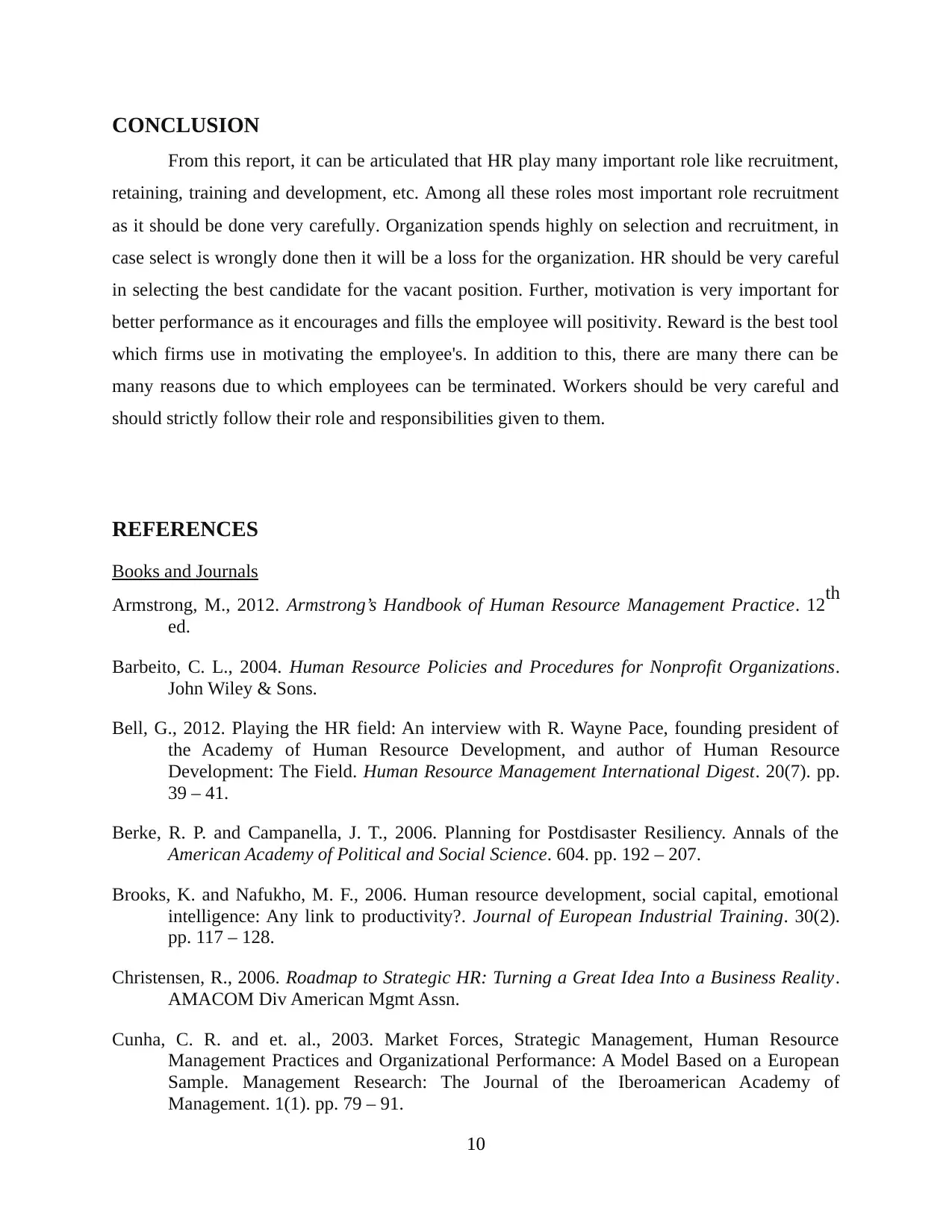
CONCLUSION
From this report, it can be articulated that HR play many important role like recruitment,
retaining, training and development, etc. Among all these roles most important role recruitment
as it should be done very carefully. Organization spends highly on selection and recruitment, in
case select is wrongly done then it will be a loss for the organization. HR should be very careful
in selecting the best candidate for the vacant position. Further, motivation is very important for
better performance as it encourages and fills the employee will positivity. Reward is the best tool
which firms use in motivating the employee's. In addition to this, there are many there can be
many reasons due to which employees can be terminated. Workers should be very careful and
should strictly follow their role and responsibilities given to them.
REFERENCES
Books and Journals
Armstrong, M., 2012. Armstrong’s Handbook of Human Resource Management Practice. 12th
ed.
Barbeito, C. L., 2004. Human Resource Policies and Procedures for Nonprofit Organizations.
John Wiley & Sons.
Bell, G., 2012. Playing the HR field: An interview with R. Wayne Pace, founding president of
the Academy of Human Resource Development, and author of Human Resource
Development: The Field. Human Resource Management International Digest. 20(7). pp.
39 – 41.
Berke, R. P. and Campanella, J. T., 2006. Planning for Postdisaster Resiliency. Annals of the
American Academy of Political and Social Science. 604. pp. 192 – 207.
Brooks, K. and Nafukho, M. F., 2006. Human resource development, social capital, emotional
intelligence: Any link to productivity?. Journal of European Industrial Training. 30(2).
pp. 117 – 128.
Christensen, R., 2006. Roadmap to Strategic HR: Turning a Great Idea Into a Business Reality.
AMACOM Div American Mgmt Assn.
Cunha, C. R. and et. al., 2003. Market Forces, Strategic Management, Human Resource
Management Practices and Organizational Performance: A Model Based on a European
Sample. Management Research: The Journal of the Iberoamerican Academy of
Management. 1(1). pp. 79 – 91.
10
From this report, it can be articulated that HR play many important role like recruitment,
retaining, training and development, etc. Among all these roles most important role recruitment
as it should be done very carefully. Organization spends highly on selection and recruitment, in
case select is wrongly done then it will be a loss for the organization. HR should be very careful
in selecting the best candidate for the vacant position. Further, motivation is very important for
better performance as it encourages and fills the employee will positivity. Reward is the best tool
which firms use in motivating the employee's. In addition to this, there are many there can be
many reasons due to which employees can be terminated. Workers should be very careful and
should strictly follow their role and responsibilities given to them.
REFERENCES
Books and Journals
Armstrong, M., 2012. Armstrong’s Handbook of Human Resource Management Practice. 12th
ed.
Barbeito, C. L., 2004. Human Resource Policies and Procedures for Nonprofit Organizations.
John Wiley & Sons.
Bell, G., 2012. Playing the HR field: An interview with R. Wayne Pace, founding president of
the Academy of Human Resource Development, and author of Human Resource
Development: The Field. Human Resource Management International Digest. 20(7). pp.
39 – 41.
Berke, R. P. and Campanella, J. T., 2006. Planning for Postdisaster Resiliency. Annals of the
American Academy of Political and Social Science. 604. pp. 192 – 207.
Brooks, K. and Nafukho, M. F., 2006. Human resource development, social capital, emotional
intelligence: Any link to productivity?. Journal of European Industrial Training. 30(2).
pp. 117 – 128.
Christensen, R., 2006. Roadmap to Strategic HR: Turning a Great Idea Into a Business Reality.
AMACOM Div American Mgmt Assn.
Cunha, C. R. and et. al., 2003. Market Forces, Strategic Management, Human Resource
Management Practices and Organizational Performance: A Model Based on a European
Sample. Management Research: The Journal of the Iberoamerican Academy of
Management. 1(1). pp. 79 – 91.
10
⊘ This is a preview!⊘
Do you want full access?
Subscribe today to unlock all pages.

Trusted by 1+ million students worldwide
1 out of 14
Related Documents
Your All-in-One AI-Powered Toolkit for Academic Success.
+13062052269
info@desklib.com
Available 24*7 on WhatsApp / Email
![[object Object]](/_next/static/media/star-bottom.7253800d.svg)
Unlock your academic potential
Copyright © 2020–2025 A2Z Services. All Rights Reserved. Developed and managed by ZUCOL.





